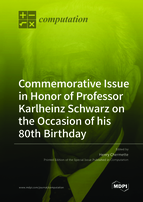Density Functional Theory of Coulombic Excited States Based on Nodal Variational Principle†
Round 1
Reviewer 1 Report
The author is a world renounced expert on this topic and this theoretical work is a continuation of many of her excellent theoretical developments in density functional theory. The manuscript is clear, novel, easy to follow and well written. To accept as is is my recommendation.
Author Response
The author is a world renounced expert on this topic and this theoretical work
is a continuation of many of her excellent theoretical developments in
density functional theory. The manuscript is clear, novel, easy to follow and
well written. To accept as is is my recommendation.
There were no questions.
Reviewer 2 Report
Please see my attached Report.
Comments for author File: ![]() Comments.pdf
Comments.pdf
Author Response
The article presents an elegant combination of the recently formulated nodal
variational principle for excited states with a Kohn-Sham approach to excited
states based on the rigorous Coulombic density functional formalism developed by the author with collaborators. The possible implications of the presented approach are both conceptual and practical. It would be interesting to find if one can utilize any known properties of Kohn-Sham orbital nodes in the presented approach.
Answer:
The present approach can be utilized in the solution of KS equation. It is
especially useful for highly excited states. More detail are added on
the example shown in Discussion.
Reviewer 3 Report
The article presents an elegant combination of the recently formulated nodal variational principle for excited states with a Kohn-Sham approach to excited states based on the rigorous Coulombic density functional formalism developed by the author with collaborators. The possible implications of the presented approach are both conceptual and practical. It would be interesting to find if one can utilize any known properties of Kohn-Sham orbital nodes in the presented approach.
Author Response
Please see attachment.
Author Response File: ![]() Author Response.pdf
Author Response.pdf
Round 2
Reviewer 2 Report
The author has made the requisite changes.






